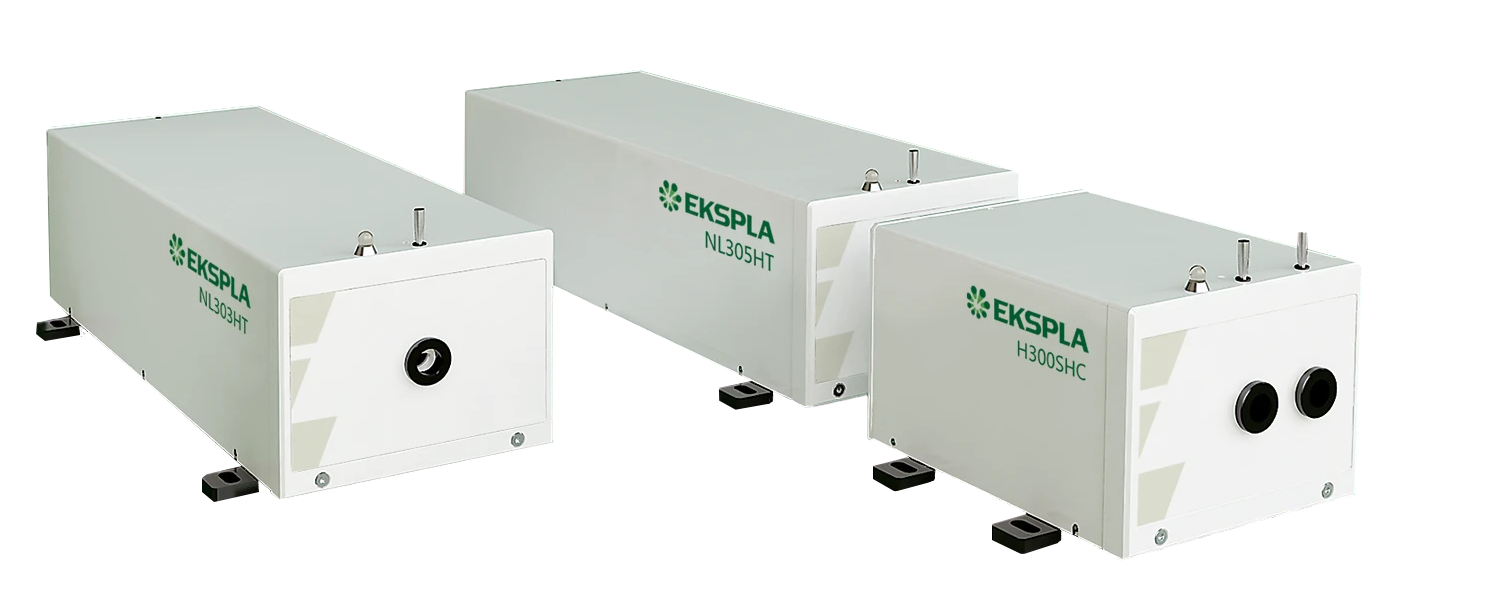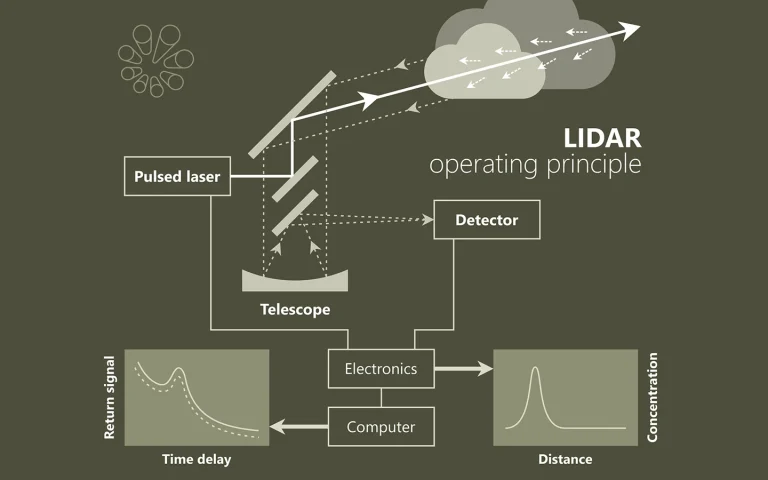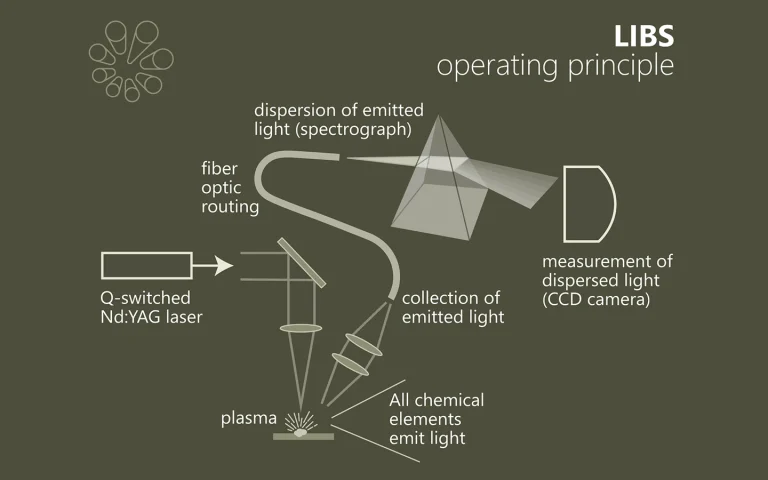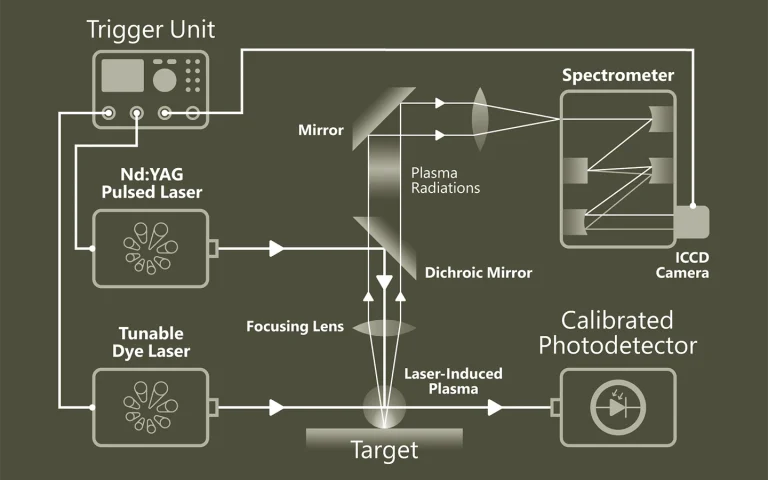NL300
Kompakter Blitzlampen-gepumpter Nd:YAG Laser
Die elektro-optisch Gütegeschalteten Nanosekundenlaser der NL300-Serie erzeugen energieintensive Pulse mit 3–6 ns Dauer bei Wiederholraten bis 20 Hz. Module zur Erzeugung bis zur 5. Harmonischen (Nd:YAG) sind optional verfügbar.

Features
- Zwei Jahre Gewährleistung
- Robuste, versiegelte Laserkavität
- Bis zu 1100 mJ Pulsenergie
- Pulsenergie-Stabilität besser als 1 % Standardabweichung
- 5–20 Hz Pulswiederholrate
- 3–6 ns Pulsdauer
- Thermostabilisierte Module für zweite, dritte, vierte und fünfte Harmonische
- Optionale Abschwächer für Grund- und/oder Harmonische Wellenlängen
- Wasser-Wasser- oder Wasser-Luft-Kühlungsoptionen
- Austausch der Blitzlampen ohne Justage der Laserkavität
- Fernsteuerung über Tastenfeld und/oder RS232-/USB-Schnittstelle
Anwendungen
- Materialablation
- LIBS (Laserinduzierte Plasmaspektroskopie)
- OPO-Pumpen
- Fernerkundung
- LIDAR (Light Detection and Ranging)
- Massenspektrometrie
- LIF (Laserinduzierte Fluoreszenz)
Anwendungen

Distanz als Datenquelle
LIDAR sendet kurze Laserpulse aus, die an Partikeln, Aerosolen oder Molekülen in der Atmosphäre gestreut und von einem Teleskop detektiert werden. Aus der Laufzeit des Lichts wird die Entfernung berechnet – so entsteht ein räumliches Profil entlang des Strahls. LIDAR nutzt UV-, sichtbares oder nahinfrarotes Licht und eignet sich zur Detektion verschiedenster Materialien – auch in schwer zugänglichen Umgebungen.

Zerstörung für präzise Erkenntnisse
Die laserinduzierte Plasmaspektroskopie (LIBS) ist eine schnelle, zerstörungsarme Methode zur Bestimmung der Elementzusammensetzung von Materialien. Ein intensiver Laserpuls erzeugt auf der Probenoberfläche ein Plasma, dessen charakteristische Emission analysiert wird. LIBS eignet sich für nahezu alle Materialarten – fest, flüssig oder gasförmig – und ist besonders wertvoll für Anwendungen, bei denen eine schnelle, ortsaufgelöste oder …

Analyse ionisierter Materie
Hochenergetische Laserpulse erzeugen Plasmen für vielfältige Anwendungen wie Elementanalytik (LIBS), Dünnschichtabscheidung (PLD), Explosivstoffdetektion, Umweltanalytik und planetare Exploration. Fortschritte in der Kurzpuls-Technologie ermöglichen zudem kompakte EUV- und Röntgenquellen für Lithografie, Materialdiagnostik und zeitaufgelöste Experimente.
Anwendungen
Wissenschafliche Veröffentlichungen
Effects of pressure and substrate temperature on the growth of Al-doped ZnO films by pulsed laser deposition
R. Kek, K. Tan, C. H. Nee, S. L. Yap, S. F. Koh, A. K. B. H. M. Arof et al., Materials Research Express 7 (1), 016414 (2020). DOI: 10.1088/2053-1591/ab62f8.
Al-doped ZnO (AZO) thin films were deposited on p-Si (100) by pulsed laser deposition from a composite ceramic target (ZnO:Al2O3) by using 355 nm laser at different O2 background pressure and substrate temperature. Upon ablation at laser fluence of 2 Jcm−2, plasma plume consists of Zn neutrals and ions, Al neutrals and O neutral are formed. As the O2 background pressure increases from 3 Pa to 26 Pa, the energy of the plasma species are moderated. The results show that the ions density and velocity reduced significantly above 13 Pa. The velocity of the ions reduced from 14 kms−1 to 11 kms−1 at 13 Pa, while the ions energy reduced from 63 eV to 42 eV respectively. Below 13 Pa, crystalline and homogeneous AZO nanostructured films were formed. Above 13 Pa, the process results in low crystallinity films with higher porosity. The resistivity of the films also increases from 0.1 ohmcm to 24 ohmcm as the pressure increased. At fixed O2 background pressure of 3 Pa, the adatom mobility of atoms on the substrates is altered by substrate heating. The resistivity of the films decreased to 10–3 ohmcm when the substrates are heated to 100 °C–300 °C during deposition. The films with highest carrier density of 1020 cm−3 and carrier mobility of 13 cmV−1 s−1 are achieved at 200 °C.
Iminothioindoxyl as a molecular photoswitch with 100 nm band separation in the visible range
M. W. Hoorens, M. Medved’, A. D. Laurent, M. Di Donato, S. Fanetti, L. Slappendel et al., Nature Communications 10 (1), 2390 (2019). DOI: 10.1038/s41467-019-10251-8.
Light is an exceptional external stimulus for establishing precise control over the properties and functions of chemical and biological systems, which is enabled through the use of molecular photoswitches. Ideal photoswitches are operated with visible light only, show large separation of absorption bands and are functional in various solvents including water, posing an unmet challenge. Here we show a class of fully-visible-light-operated molecular photoswitches, Iminothioindoxyls (ITIs) that meet these requirements. ITIs show a band separation of over 100 nm, isomerize on picosecond time scale and thermally relax on millisecond time scale. Using a combination of advanced spectroscopic and computational techniques, we provide the rationale for the switching behavior of ITIs and the influence of structural modifications and environment, including aqueous solution, on their photochemical properties. This research paves the way for the development of improved photo-controlled systems for a wide variety of applications that require fast responsive functions.
Conversion efficiency of a laser-plasma source based on a Xe jet in the vicinity of a wavelength of 11 nm
N. I. Chkhalo, S. A. Garakhin, A. Y. Lopatin, A. N. Nechay, A. E. Pestov, V. N. Polkovnikov et al., AIP Advances 8 (10), 105003 (2018). DOI: 10.1063/1.5048288.
We optimized the parameters of a laser-produced plasma source based on a solid-state Nd: YAG laser (λ = 1.06 nm, pulse duration 4 ns, energy per pulse up to 500 mJ, repetition rate 10 Hz, lens focus distance 45 mm, maximum power density of laser radiation in focus 9 × 1011 W/cm2) and a double-stream Xe/He gas jet to obtain a maximum of radiation intensity around 11 nm wavelength. It was shown that the key factor determining the ionization composition of the plasma is the jet density. With the decreased density, the ionization composition shifts toward a smaller degree of ionization, which leads to an increase in emission peak intensity around 11 nm. We attribute the dominant spectral feature centred near 11 nm originating from an unidentified 4d-4f transition array in Xe+10…+13 ions. The exact position of the peak and the bandwidth of the emission line were determined. We measured the dependence of the conversion efficiency of laser energy into an EUV in-band energy with a peak at 10.82 nm from the xenon pressure and the distance between the nozzle and the laser focus. The maximum conversion efficiency (CE) into the spectral band of 10–12 nm measured at a distance between the nozzle and the laser beam focus of 0.5 mm was CE = 4.25 ± 0.30%. The conversion efficiencies of the source in-bands of 5 and 12 mirror systems at two wavelengths of 10.8 and 11.2 nm have been evaluated; these efficiencies may be interesting for beyond extreme ultraviolet lithography.
